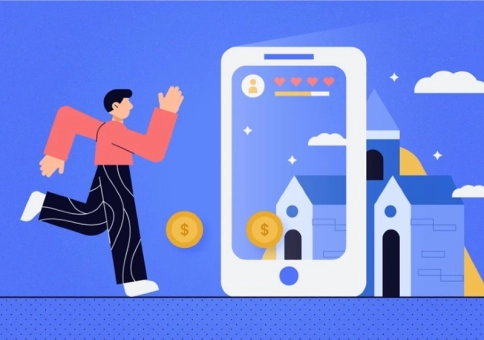How to Create a Powerful Social Network Platform
What’s that one app that everyone has on their phone? Definitely some kind of a social media platform. Since the very first social network, people have been spending hours chatting, sharing pictures, discussing hot topics, friending and unfriending, much to the app owners’ and advertisers’ delight.
Creating your own social media platform is the easiest way to slip into your client’s pocket, literally and figuratively, so let’s see how you can do it in several simple steps.
Image by pch.vector on Freepik
Market Overview, or Do We Really Need Just Another Social Media App?
If everyone already has a social media app on their phone, what’s the point of creating one more, you might ask. Isn’t the market already saturated enough? Won’t your platform get lost among the industry leaders? Well, if everyone was doubting like that, we wouldn’t have BeReal, Mastodon, Hive, and other fresh-of-the-box social networks that are quickly gaining popularity. As long as the platform is properly built, looks nice, and brings something new to the table, it will have its spot even in the tightest market.
Here are some numbers to prove the social media scene is only going to grow:
- The market is expected to show an annual growth rate (CAGR) of 6.86% from 2022 to 2027, resulting in a projected market volume of US$183.10 billion by 2027.
- There are an estimated 4.9 billion social media users worldwide as of 2023. This number is expected to grow to 5.85 billion by 2027. Will some of them be using your app?
- Social media advertising spending is expected to reach US$207.10 billion in 2023. This number is expected to grow to US$247.30 billion by 2027.
So, what we see is the growth. More and more people will be using social networks, more and more ads will be sold, more and more products will emerge on the market, so there won’t be a better time for building community platforms than now.
At the moment, the largest social media platforms in terms of active users are:
- Facebook: 2.91 billion
- YouTube: 2.56 billion
- WhatsApp: 2.00 billion
- Instagram: 1.49 billion
- TikTok: 1.28 billion
While the main trends have remained more or less the same for the last few years (short-form videos, live streaming, all types of user-generated content), uniqueness is 100% the key to success. You need to make your idea worth it — and we can help with the rest.
Image by Josef Mucira from Pixabay
Types of Social Media Platforms
Unless you come up with something completely unique, the social network you build will most likely fall into one of these categories:
Social networking platforms. These platforms allow users to connect with friends and family, as well as make new connections. They can also be professionally oriented, like LinkedIn, or niche social media platforms like Dribble for designers or Flixter for movie fans.
Photo and video sharing platforms. These platforms allow users to share photos, videos, and other media content with their followers. Instagram, TikTok, and Snapchat are the all-time favorites in this category.
Microblogging platforms. These platforms allow users to share short messages, or "microblogs," with their followers. Twitter is the most popular microblogging platform at the moment, but the latest events show that it can quickly change — Mastodon and BlueSky are already quickly growing their user bases.
Other content-sharing platforms. These platforms allow users to share a variety of content, including text, photos, videos, and links. It’s Pinterest for pictures and ideas, YouTube for videos, and Reddit for….well, everything.
Messaging platforms. These platforms allow users to send private messages to each other. WhatsApp, Facebook Messenger, Telegram, and WeChat are not social media platforms themselves but can be integrated inside one.
Image by Gordon Johnson from Pixabay
How to Create A Social Network App in 8 Steps
Now that you understand the sea you are diving into, it’s time to build your own social media platform. The process might vary depending on the project type, team size, and budget, but in most cases, it will include the following steps.
Start with planning and conceptualization
First of all, you’ll need to define the niche and purpose of your social network app. Are you targeting professionals, hobbyists, or a specific community? Identify the key features you want to include, such as messaging, user profiles, groups, events, or forums. Conduct competitor analysis to understand what works well in similar apps and what gaps you can fill. Develop a comprehensive user persona to ensure your app caters to your target audience's specific needs.
Design the UI and UX
The social network design is no less important than its functionality — while users like it when it works well, they also like it when it looks well. So at this point, your team of designers will need to create a clean and intuitive user interface that aligns with your app's theme and target audience. It can be helpful to use wireframes and mockups to visualize the app's flow and interactions.
User experience is another thing that can make your app a hit or miss. With the competition so high, the users will delete the app as soon as they can’t find a necessary button within 2 seconds, so you need to ensure smooth navigation and a straightforward user journey.
Pro tip: Prioritize mobile responsiveness as most users will access your app from smartphones.
Develop the backend
The backend is the foundation of your product, even though it’s something you don’t see. In this step, you’ll be required to select a suitable technology stack, considering factors like scalability, security, and ease of development. The popular options are Node.js, Ruby on Rails, and Java, but the actual pool of technologies you can use to build a social media app is much wider.
While working on the backend, the developers will need to:
- Build a robust database to store user information, posts, and media;
- Implement a secure user authentication system using OAuth or other industry-standard methods;
- Design APIs to facilitate seamless communication between the frontend and backend;
- Ensure that your backend can handle potential spikes in user activity as your app gains popularity.
Continue with features development
With the solid backend in place, you can start developing the frontend as well as the core features of your social network app. These features may include user profiles, friend requests, timelines, news feeds, comments, likes, and media sharing, depending on the type of platform you are building. The main focus here should be on making each feature seamless and responsive to enhance user engagement — the key factor for the social media app’s success.
Test and fix the issues
QAs are the FBI of the social network development process. They will leave no stone unturned to find the pesky bugs that could spoil your user experience. In most cases, the QA process will include unit testing, integration testing, and end-to-end testing to ensure all components work harmoniously. For big projects, you can also enlist beta testers to provide feedback from the user's perspective. Don’t forget to monitor server performance and load testing to avoid crashes during peak usage.
Pick a monetization strategy
When you create your own social network, you don’t do it just for the idea, do you? While the fun and satisfaction of users is nice gratitude itself, it would be nice if the app also brought you money, so you’ll need to come up with a suitable monetization strategy. Among the popular options, there are:
- In-App Advertising. Display targeted advertisements to users based on their interests and interactions within the app. Offer different ad formats such as banner ads, sponsored posts, or video ads.
- Freemium Model. Provide a basic version of the app for free with limited features, and offer premium subscriptions for access to exclusive features and content.
- Virtual Goods and Gifts. Allow users to purchase virtual items, stickers, or gifts to enhance their interactions and express themselves within the app.
- Paid Emojis and Filters. Offer unique and customizable emojis, filters, and special effects that users can purchase to enhance their posts and stories.
- Data Insights and Analytics. Provide businesses and influencers with valuable data insights and analytics about their audience's behavior and engagement for a fee.
- Sponsored Content and Influencer Marketing. Partner with brands to promote sponsored content or collaborate with influencers to promote products or services to their followers.
- Paid Access to Exclusive Content. Offer premium access to exclusive content, tutorials, or behind-the-scenes footage from celebrities, creators, or experts.
- Subscription-Based Communities. Create a subscription-based private social network with specialized content and discussions.
- Pay-to-Promote Posts. Allow users to boost their posts or stories to reach a broader audience within the app.
- Gamification and Challenges. Introduce in-app challenges or games that users can participate in for a fee, with the chance to win rewards or recognition.
- E-commerce Integration. Enable users to buy products directly from the app, earning a commission from each sale.
- App Partnerships and Collaborations. Partner with other apps or platforms for cross-promotion or integration, creating additional revenue streams.
- Native Content Creation Tools. Offer specialized tools or templates for content creation, like photo editors, video makers, or story templates, with optional premium features.
Remember, the most effective monetization strategy for your social media app will depend on your target audience, the app's niche, and the value you provide to users. Combining multiple strategies and testing their performance will help you find the best approach to generate sustainable revenue while keeping users engaged and satisfied.
Launch and deploy the app
Launching your social network app is an exciting milestone, but it requires careful planning and execution for the app to fly right from the start. Before the big day comes, you need to prepare a robust marketing strategy to maximize visibility. Craft a captivating app description and use appealing visuals for app stores to entice potential users. Leverage the power of social media and online communities to create buzz around your app. Consider offering limited-time promotions or incentives to attract initial users and encourage them to spread the word.
Maintain and update your platform
Post-launch, the journey has just begun. To keep users engaged and satisfied, it's essential to maintain and improve your social network app continuously, so you should be all about user feedback. To stay on the crest of the wave, prioritize feature requests and address any reported bugs promptly. Regularly analyze app metrics to identify areas for improvement and discover potential growth opportunities.
Remember, a thriving online community is built on continuous improvement and delivering a unique value proposition that sets your app apart from competitors. Embrace this journey with passion and dedication, and your social network app can truly flourish.
How Fetocan Can Help You Build Your Own Social Network
If you have the vision to create your own social network app but are unsure where to start, look no further than Fetocan. We can transform the idea into reality, at a reasonable cost and terms. The services we provide include but are not limited to:
- Web development (both backend and frontend)
- Mobile development
- Quality assurance
- Business analysis
… meaning we can do everything for your app to turn out awesome. We’ll help you at every stage of the process, starting with choosing the right tech stack and up to the very launch — and after it.
FAQ
What are the essential features needed in a social media app?
The core features of social media apps usually include user profiles, news feeds, messaging, and media sharing. The additional features might vary depending on the specifics of your product.
How can I analyze and measure the success of my social media app?
To stay aware of your app’s success, you’ll need to learn about app analytics tools and performance metrics to track the key performance indicators such as user engagement, retention rates, user growth rate, daily/monthly active users, CPA, and others.
How much does it cost to develop a social network?
The final cost of development significantly depends on the product’s complexity and functionality. Generally speaking, the cost starts at $35,000. However, it is possible to develop a social media app for less than $35,000 if you are willing to sacrifice some features and functionality.











